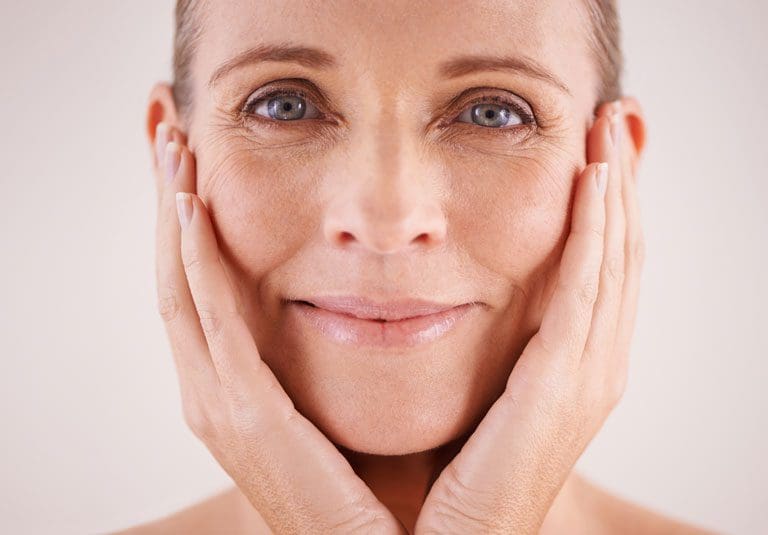
The ageing process is a natural and inevitable part of life, and our skin reflects this journey in various ways. Often overlooked in our youth, it becomes increasingly evident as we age that our skin tells a story of its own. From the fine lines that begin to appear to the loss of elasticity, understanding what happens to our skin as it ages can empower us to take better care of our outer layer and embrace the beauty of ageing gracefully.
The Effects of Time
Over time, our skin naturally loses elasticity, moisture, and thickness, leading to the formation of wrinkles, fine lines and sagging. This is due to a decrease in the production of collagen and elastin, two proteins responsible for maintaining the skin’s structure and firmness. The decline in collagen and elastin production is primarily attributed to both intrinsic and extrinsic factors.
Intrinsic factors include genetic predisposition and hormonal changes that occur with ageing. As we get older, the body’s ability to produce collagen and elastin decreases due to a variety of hormonal shifts and genetic factors. This decline starts as early as our twenties but becomes more pronounced with each passing decade.
Extrinsic factors, such as sun exposure, pollution, smoking and poor nutrition, also contribute to the accelerated breakdown of collagen and elastin. The overall rate at which these proteins break down can vary from person to person, with the decline in production typically causing levels to deplete by around 1-1.5% every year.
Sun Damage
One of the primary contributors to premature ageing is sun exposure. UV radiation from the sun is particularly damaging to both the epidermis (outer layer of the skin) and the dermis (middle layer of the skin). This is because it promotes the production of free radicals (unstable atoms that can damage cells) that attack collagen and elastin fibres, leading to premature ageing. Ultraviolet rays penetrate the skin, causing damage to collagen fibres which will eventually lead to the formation of wrinkles, age spots, and uneven pigmentation (skin colouration). Prolonged sun exposure can also increase the risk of skin cancer, emphasising the importance of sun protection throughout life.
Decline in Cell Turnover
As we age, the rate of cell turnover slows down. The skin’s ability to self-exfoliate relies on the skin’s natural exfoliation processes, such as the desquamation of corneocytes (skin shedding) and the activity of enzymes responsible for breaking down old skin cells. As these responses slow down, it leads to a buildup on the surface that contributes to a dull complexion and a rough texture. Factors such as hormonal changes, decreased circulation, and cumulative sun damage can further impair these processes. As a result, regular exfoliation becomes increasingly important in the skincare routine of ageing individuals to help remove dead skin cells, promote cell renewal, and maintain a vibrant, youthful complexion.
Loss of Hydration
Ageing skin tends to become drier as oil production decreases and the skin’s natural moisture barrier weakens. Moisture loss can then be exacerbated through exposure to seasonal climate changes, certain weather conditions (wind and cold), and central heating / air conditioning at work or home. This can lead to roughness, flakiness, and an increased susceptibility to irritation as the skin dries out. Hydration becomes essential, both internally through adequate water intake and externally through the use of moisturisers and hydrating skincare ingredients like hyaluronic acid.
Appearance of Age Spots and Discoloration
Melanin plays a crucial role in determining the colour of our skin, hair, and eyes. Produced by melanocytes, specialised cells located in the basal layer of the epidermis, melanin serves as a natural defence mechanism against the harmful effects of UV radiation from the sun. When the skin is exposed to sunlight, melanocytes produce more melanin, which absorbs and dissipates UV radiation, helping to protect the skin from sun damage. However, as we age, various factors such as cumulative sun exposure, hormonal changes, and genetic predisposition can disrupt the regulation of melanin production, leading to the development of pigmentation irregularities. Over time, accumulated sun exposure can cause melanin to become unevenly distributed in the skin. Pigmented cells can accumulate and bunch together, resulting in the formation of freckles or small darkened patches, also known as age spots, sunspots or liver spots (often referred to as hyperpigmentation). Melanin production is permanent, and the deeper the pigmented cells, the chance of these cells coming to the surface and expelling is reduced. The natural ageing process can cause melanocytes to become less evenly distributed in the skin, further contributing to pigmentation changes.
Thinning of the Epidermis
As skin ages, it undergoes a process called intrinsic ageing, during which various structural changes occur. One significant change is the thinning of the epidermis, the outermost layer of the skin. This thinning primarily results from a decrease in the production of collagen and elastin, two proteins crucial for maintaining skin thickness and elasticity. This is accompanied with low cellular turnover and the buildup of dead skin cells on the surface, which can make the skin appear thinner. Hormonal changes, genetic factors, and environmental stressors such as sun exposure can also contribute to the thinning of ageing skin. As a result, aged skin becomes more fragile, prone to damage, and slower to heal. This can result in slower wound healing and an increased susceptibility to bruising and tearing. Protecting the skin from trauma and injury becomes crucial, as well as supporting its natural repair processes through proper nutrition and skincare.
By understanding the changes that occur in the skin as we age, we can better care for and nurture our skin to maintain its health and vitality. Embracing the beauty of ageing gracefully involves not only external skincare but also internal wellness and self-care practices that nourish both body, soul, and skin. With the growth of aesthetic and cosmetic medicine, we can support lifestyle choices and skincare regimes with in-clinic treatments and procedures that improve the quality and condition of the skin, reduce the signs of ageing, and help you to hold onto your youthful looks for longer.
Mr Waseem Bhat is an experienced consultant plastic, cosmetic and reconstructive surgeon who sees many patients seeking a long-term anti-ageing solution. He can perform a range of cosmetic procedures for the face, including: brow lift, blepharoplasty (upper and lower), face lift and neck lift, which refresh and revitalise the appearance.
Click here to find out more about Mr Waseem Bhat.
Back to blog



